Check Alfa Romeo Giulietta 2013 Owner handbook (in English)
[x] Cancel search | Manufacturer: ALFA ROMEO, Model Year: 2013, Model line: Giulietta, Model: Alfa Romeo Giulietta 2013Pages: 292, PDF Size: 13.06 MB
Page 97 of 292
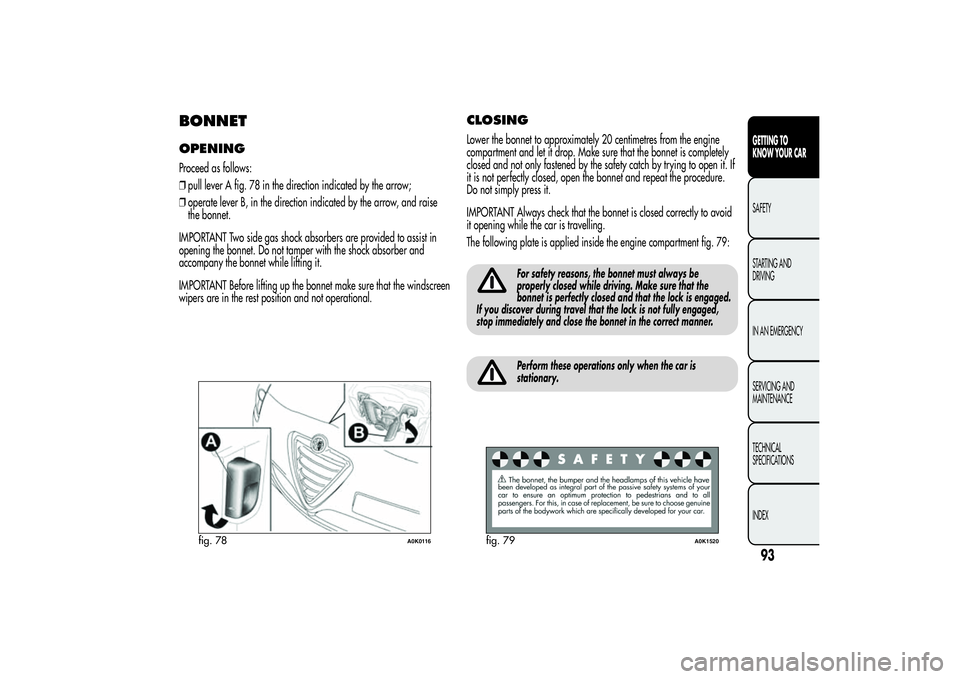
BONNETOPENINGProceed as follows:
❒pull lever A fig. 78 in the direction indicated by the arrow;
❒operate lever B, in the direction indicated by the arrow, and raise
the bonnet.
IMPORTANT Two side gas shock absorbers are provided to assist in
opening the bonnet. Do not tamper with the shock absorber and
accompany the bonnet while lifting it.
IMPORTANT Before lifting up the bonnet make sure that the windscreen
wipers are in the rest position and not operational.
CLOSINGLower the bonnet to approximately 20 centimetres from the engine
compartment and let it drop. Make sure that the bonnet is completely
closed and not only fastened by the safety catch by trying to open it. If
it is not perfectly closed, open the bonnet and repeat the procedure.
Do not simply press it.
IMPORTANT Always check that the bonnet is closed correctly to avoid
it opening while the car is travelling.
The following plate is applied inside the engine compartment fig. 79:
For safety reasons, the bonnet must always be
properly closed while driving. Make sure that the
bonnet is perfectly closed and that the lock is engaged.
If you discover during travel that the lock is not fully engaged,
stop immediately and close the bonnet in the correct manner.Perform these operations only when the car is
stationary.
fig. 78
A0K0116
fig. 79
A0K1520
93GETTING TO
KNOW YOUR CARSAFETY
STARTING AND
DRIVING
IN AN EMERGENCY
SERVICING AND
MAINTENANCE
TECHNICAL
SPECIFICATIONS
INDEX
Page 98 of 292
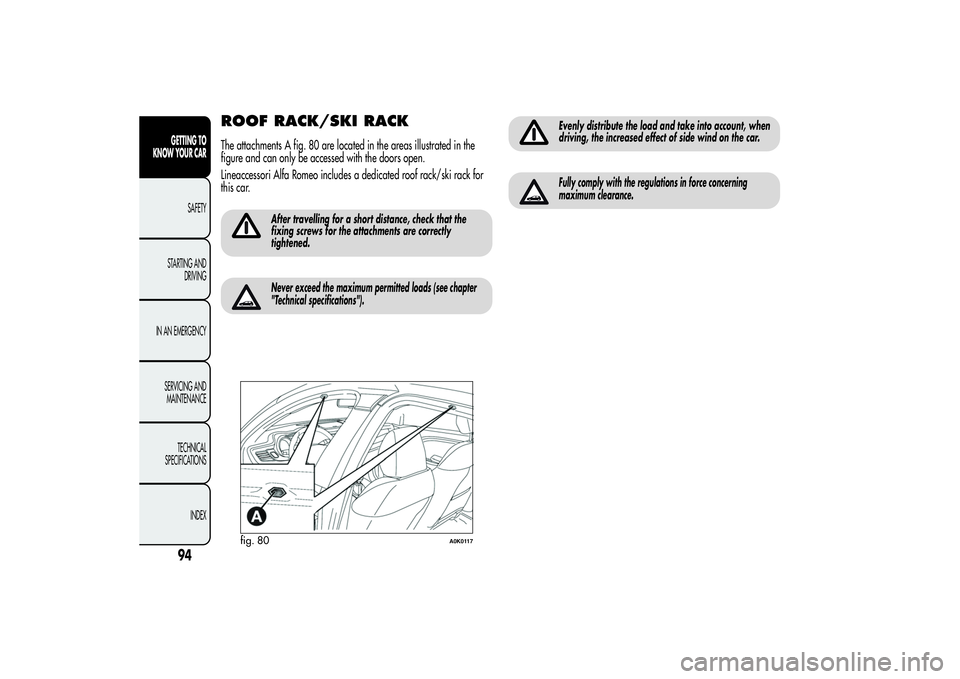
ROOF RACK/SKI RACKThe attachments A fig. 80 are located in the areas illustrated in the
figure and can only be accessed with the doors open.
Lineaccessori Alfa Romeo includes a dedicated roof rack/ski rack for
this car.
After travelling for a short distance, check that the
fixing screws for the attachments are correctly
tightened.Never exceed the maximum permitted loads (see chapter
"Technical specifications").
Evenly distribute the load and take into account, when
driving, the increased effect of side wind on the car.Fully comply with the regulations in force concerning
maximum clearance.
fig. 80
A0K0117
94GETTING TO
KNOW YOUR CAR
SAFETY
STARTING AND
DRIVING
IN AN EMERGENCY
SERVICING AND
MAINTENANCE
TECHNICAL
SPECIFICATIONS
INDEX
Page 99 of 292
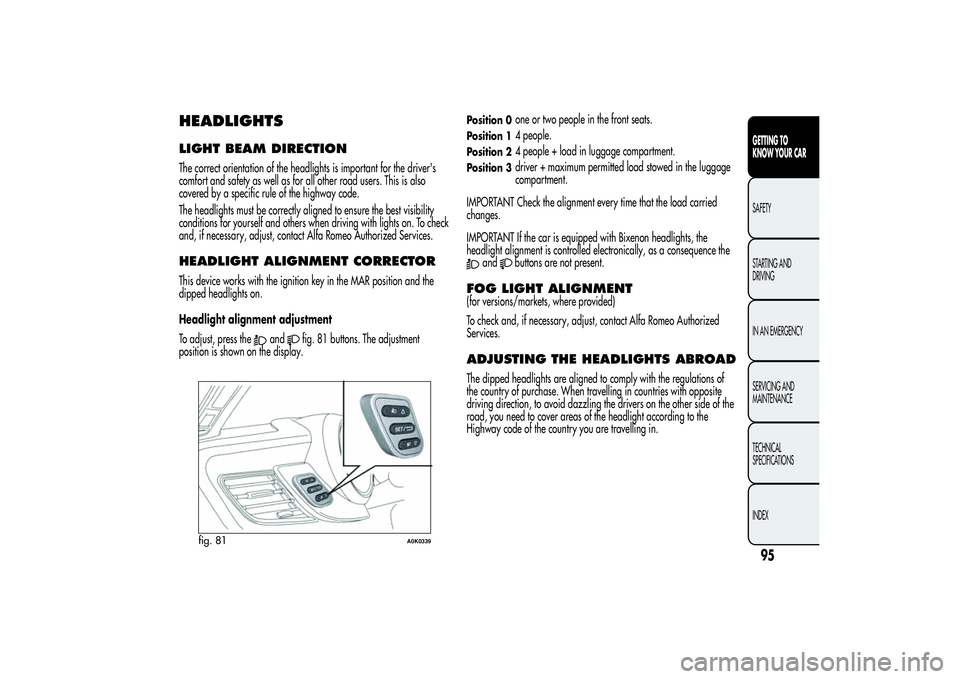
HEADLIGHTSLIGHT BEAM DIRECTIONThe correct orientation of the headlights is important for the driver's
comfort and safety as well as for all other road users. This is also
covered by a specific rule of the highway code.
The headlights must be correctly aligned to ensure the best visibility
conditions for yourself and others when driving with lights on. To check
and, if necessary, adjust, contact Alfa Romeo Authorized Services.HEADLIGHT ALIGNMENT CORRECTORThis device works with the ignition key in the MAR position and the
dipped headlights on.
Headlight alignment adjustment
To adjust, press the
and
fig. 81 buttons. The adjustment
position is shown on the display.
Position 0
one or two people in the front seats.
Position 1
4 people.
Position 2
4 people + load in luggage compartment.
Position 3
driver + maximum permitted load stowed in the luggage
compartment.
IMPORTANT Check the alignment every time that the load carried
changes.
IMPORTANT If the car is equipped with Bixenon headlights, the
headlight alignment is controlled electronically, as a consequence the
and
buttons are not present.
FOG LIGHT ALIGNMENT(for versions/markets, where provided)
To check and, if necessary, adjust, contact Alfa Romeo Authorized
Services.ADJUSTING THE HEADLIGHTS ABROADThe dipped headlights are aligned to comply with the regulations of
the country of purchase. When travelling in countries with opposite
driving direction, to avoid dazzling the drivers on the other side of the
road, you need to cover areas of the headlight according to the
Highway code of the country you are travelling in.
fig. 81
A0K0339
95GETTING TO
KNOW YOUR CARSAFETY
STARTING AND
DRIVING
IN AN EMERGENCY
SERVICING AND
MAINTENANCE
TECHNICAL
SPECIFICATIONS
INDEX
Page 110 of 292
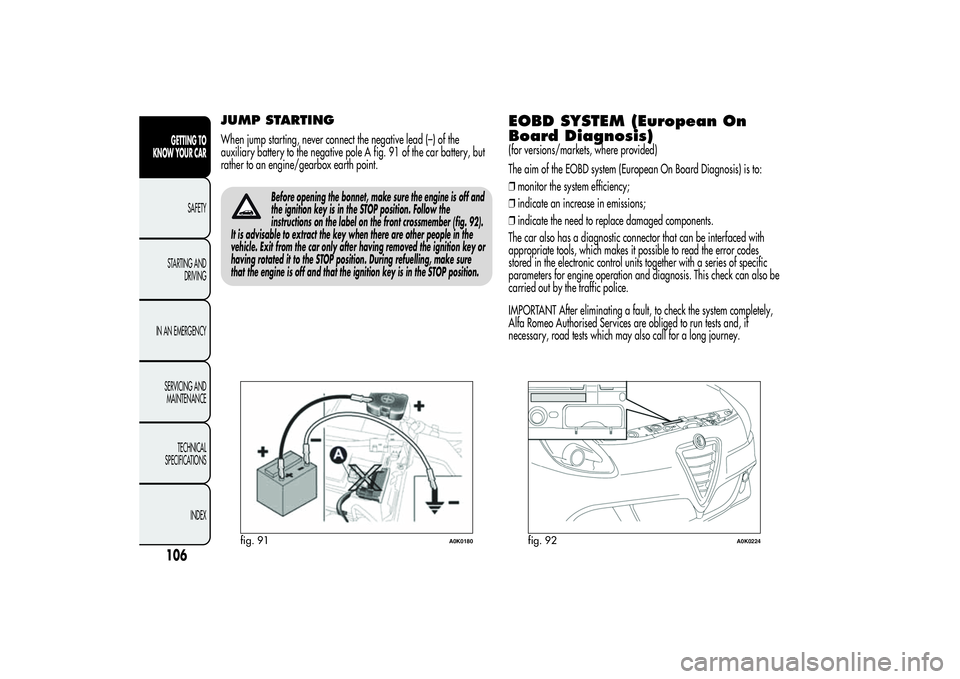
JUMP STARTINGWhen jump starting, never connect the negative lead (–) of the
auxiliary battery to the negative pole A fig. 91 of the car battery, but
rather to an engine/gearbox earth point.
Before opening the bonnet, make sure the engine is off and
the ignition key is in the STOP position. Follow the
instructions on the label on the front crossmember (fig. 92).
It is advisable to extract the key when there are other people in the
vehicle. Exit from the car only after having removed the ignition key or
having rotated it to the STOP position. During refuelling, make sure
that the engine is off and that the ignition key is in the STOP position.
EOBD SYSTEM (European On
Board Diagnosis)(for versions/markets, where provided)
The aim of the EOBD system (European On Board Diagnosis) is to:
❒monitor the system efficiency;
❒indicate an increase in emissions;
❒indicate the need to replace damaged components.
The car also has a diagnostic connector that can be interfaced with
appropriate tools, which makes it possible to read the error codes
stored in the electronic control units together with a series of specific
parameters for engine operation and diagnosis. This check can also be
carried out by the traffic police.
IMPORTANT After eliminating a fault, to check the system completely,
Alfa Romeo Authorised Services are obliged to run tests and, if
necessary, road tests which may also call for a long journey.
fig. 91
A0K0180
fig. 92
A0K0224
106GETTING TO
KNOW YOUR CAR
SAFETY
STARTING AND
DRIVING
IN AN EMERGENCY
SERVICING AND
MAINTENANCE
TECHNICAL
SPECIFICATIONS
INDEX
Page 117 of 292
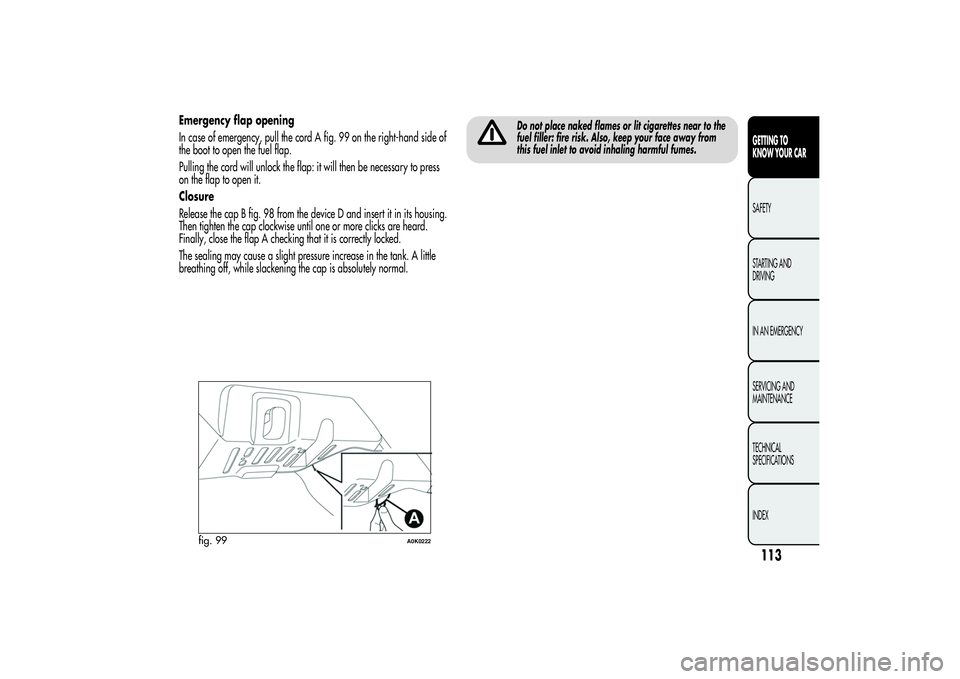
Emergency flap opening
In case of emergency, pull the cord A fig. 99 on the right-hand side of
the boot to open the fuel flap.
Pulling the cord will unlock the flap: it will then be necessary to press
on the flap to open it.
Closure
Release the cap B fig. 98 from the device D and insert it in its housing.
Then tighten the cap clockwise until one or more clicks are heard.
Finally, close the flap A checking that it is correctly locked.
The sealing may cause a slight pressure increase in the tank. A little
breathing off, while slackening the cap is absolutely normal.
Do not place naked flames or lit cigarettes near to the
fuel filler: fire risk. Also, keep your face away from
this fuel inlet to avoid inhaling harmful fumes.
fig. 99
A0K0222
113GETTING TO
KNOW YOUR CARSAFETY
STARTING AND
DRIVING
IN AN EMERGENCY
SERVICING AND
MAINTENANCE
TECHNICAL
SPECIFICATIONS
INDEX
Page 123 of 292

The pretensioner may be used only once. Once it has
been activated, contact Alfa Romeo Authorised
Workshops to have it replaced. Consult the plate in the
glove compartment to check the status of the device. Contact Alfa
Romeo Authorised Workshops to have the device replaced as
this date approaches.Operations which lead to knocks, vibrations or localised
heating (over 100°C for a maximum of 6 hours) in the area
around the pretensioners may cause damage or trigger
them. These devices are not affected by vibrations caused by
irregularities of the road surface or low obstacles such as kerbs, etc.
Contact Alfa Romeo Authorized Services for any assistance necessary.
GENERAL INSTRUCTIONS FOR USING
THE SEAT BELTSComply with (and ensure that all the other occupants of the car comply
with) the local laws in force regarding the use of seat belts. Always
fasten the seat belts before starting off.
Seat belts must also be worn by pregnant women: the risk of injury in
the event of an accident is reduced for them and the unborn child if
they are wearing a seat belt.
Pregnant women must position the lower part of the belt very low
down so that it passes over the pelvis and under the abdomen fig.
104.
The belt must not be twisted. The upper part must pass over the
shoulder and cross the chest diagonally. The lower part must adhere to
the pelvis fig. 105, not to the abdomen of the occupant. Never use
devices (clips, clamps, etc.) to hold the seat belt away from your body.
For maximum protection, keep the backrest upright,
lean back into it and make sure the seat belt fits
closely across your chest and pelvis. Always fasten the
seat belts on both the front and the rear seats! Travelling without
wearing seat belts will increase the risk of serious injury and
even death in the event of an accident.
fig. 104
A0K0250
fig. 105
A0K0012
119GETTING TO KNOW
YOUR CARSAFETYSTARTING AND
DRIVING
IN AN EMERGENCY
SERVICING AND
MAINTENANCE
TECHNICAL
SPECIFICATIONS
INDEX
Page 125 of 292
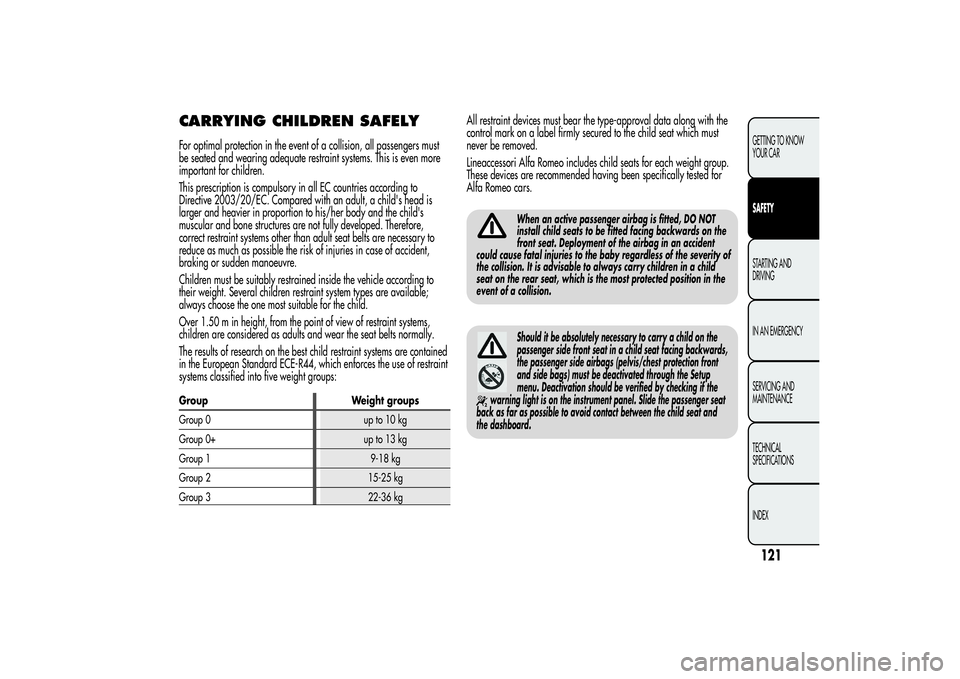
CARRYING CHILDREN SAFELYFor optimal protection in the event of a collision, all passengers must
be seated and wearing adequate restraint systems. This is even more
important for children.
This prescription is compulsory in all EC countries according to
Directive 2003/20/EC. Compared with an adult, a child's head is
larger and heavier in proportion to his/her body and the child's
muscular and bone structures are not fully developed. Therefore,
correct restraint systems other than adult seat belts are necessary to
reduce as much as possible the risk of injuries in case of accident,
braking or sudden manoeuvre.
Children must be suitably restrained inside the vehicle according to
their weight. Several children restraint system types are available;
always choose the one most suitable for the child.
Over 1.50 m in height, from the point of view of restraint systems,
children are considered as adults and wear the seat belts normally.
The results of research on the best child restraint systems are contained
in the European Standard ECE-R44, which enforces the use of restraint
systems classified into five weight groups:Group Weight groups
Group0 upto10kg
Group 0+ up to 13 kg
Group 1 9-18 kg
Group 2 15-25 kg
Group 3 22-36 kg
All restraint devices must bear the type-approval data along with the
control mark on a label firmly secured to the child seat which must
never be removed.
Lineaccessori Alfa Romeo includes child seats for each weight group.
These devices are recommended having been specifically tested for
Alfa Romeo cars.
When an active passenger airbag is fitted, DO NOT
install child seats to be fitted facing backwards on the
front seat. Deployment of the airbag in an accident
could cause fatal injuries to the baby regardless of the severity of
the collision. It is advisable to always carry children in a child
seat on the rear seat, which is the most protected position in the
event of a collision.Should it be absolutely necessary to carry a child on the
passenger side front seat in a child seat facing backwards,
the passenger side airbags (pelvis/chest protection front
and side bags) must be deactivated through the Setup
menu. Deactivation should be verified by checking if the
warning light is on the instrument panel. Slide the passenger seat
back as far as possible to avoid contact between the child seat and
the dashboard.
121GETTING TO KNOW
YOUR CARSAFETYSTARTING AND
DRIVING
IN AN EMERGENCY
SERVICING AND
MAINTENANCE
TECHNICAL
SPECIFICATIONS
INDEX
Page 129 of 292
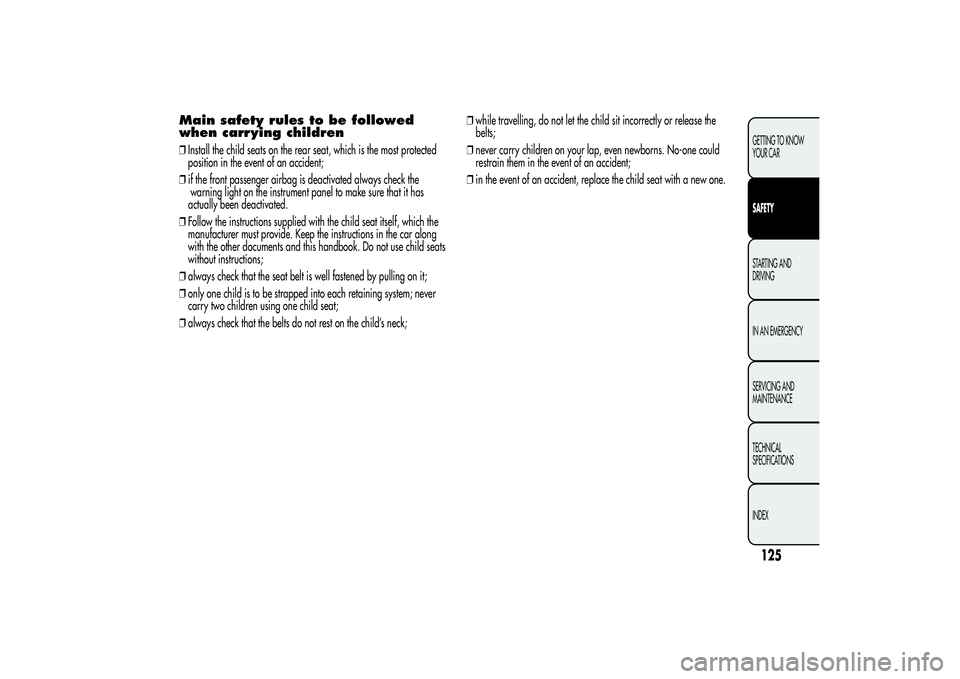
Main safety rules to be followed
when carrying children❒Install the child seats on the rear seat, which is the most protected
position in the event of an accident;
❒if the front passenger airbag is deactivated always check the
warning light on the instrument panel to make sure that it has
actually been deactivated.
❒Follow the instructions supplied with the child seat itself, which the
manufacturer must provide. Keep the instructions in the car along
with the other documents and this handbook. Do not use child seats
without instructions;
❒always check that the seat belt is well fastened by pulling on it;
❒only one child is to be strapped into each retaining system; never
carry two children using one child seat;
❒always check that the belts do not rest on the child’s neck;❒while travelling, do not let the child sit incorrectly or release the
belts;
❒never carry children on your lap, even newborns. No-one could
restrain them in the event of an accident;
❒in the event of an accident, replace the child seat with a new one.
125GETTING TO KNOW
YOUR CARSAFETYSTARTING AND
DRIVING
IN AN EMERGENCY
SERVICING AND
MAINTENANCE
TECHNICAL
SPECIFICATIONS
INDEX
Page 136 of 292
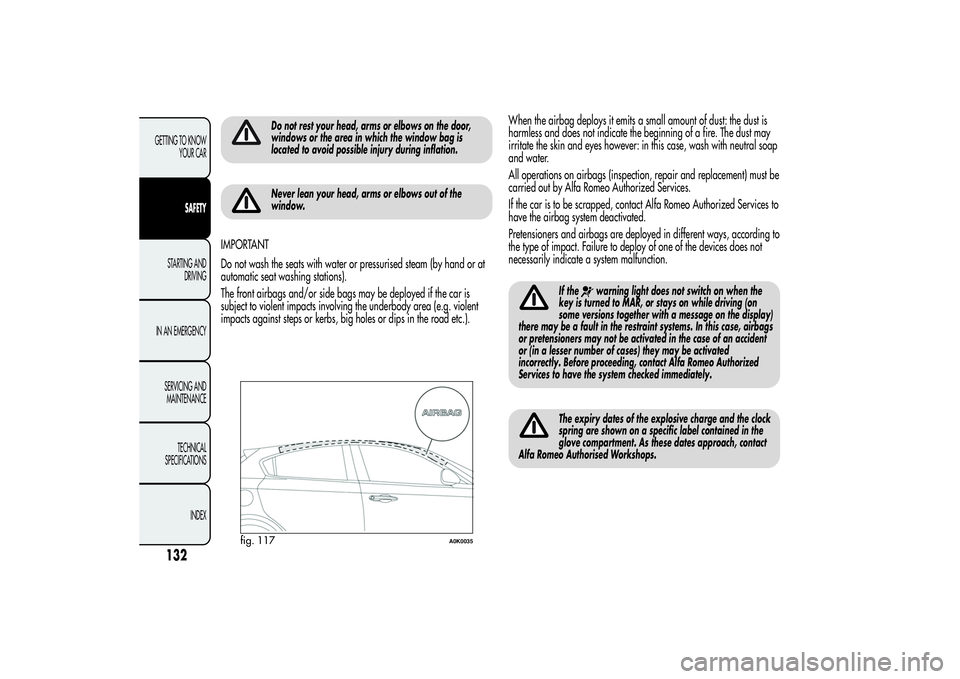
Do not rest your head, arms or elbows on the door,
windows or the area in which the window bag is
located to avoid possible injury during inflation.Never lean your head, arms or elbows out of the
window.
IMPORTANT
Do not wash the seats with water or pressurised steam (by hand or at
automatic seat washing stations).
The front airbags and/or side bags may be deployed if the car is
subject to violent impacts involving the underbody area (e.g. violent
impacts against steps or kerbs, big holes or dips in the road etc.).When the airbag deploys it emits a small amount of dust: the dust is
harmless and does not indicate the beginning of a fire. The dust may
irritate the skin and eyes however: in this case, wash with neutral soap
and water.
All operations on airbags (inspection, repair and replacement) must be
carried out by Alfa Romeo Authorized Services.
If the car is to be scrapped, contact Alfa Romeo Authorized Services to
have the airbag system deactivated.
Pretensioners and airbags are deployed in different ways, according to
the type of impact. Failure to deploy of one of the devices does not
necessarily indicate a system malfunction.
If the
warning light does not switch on when the
key is turned to MAR, or stays on while driving (on
some versions together with a message on the display)
there may be a fault in the restraint systems. In this case, airbags
or pretensioners may not be activated in the case of an accident
or (in a lesser number of cases) they may be activated
incorrectly. Before proceeding, contact Alfa Romeo Authorized
Services to have the system checked immediately.
The expiry dates of the explosive charge and the clock
spring are shown on a specific label contained in the
glove compartment. As these dates approach, contact
Alfa Romeo Authorised Workshops.
fig. 117
A0K0035
132GETTING TO KNOW
YOUR CAR
SAFETY
STARTING AND
DRIVING
IN AN EMERGENCY
SERVICING AND
MAINTENANCE
TECHNICAL
SPECIFICATIONS
INDEX
Page 141 of 292
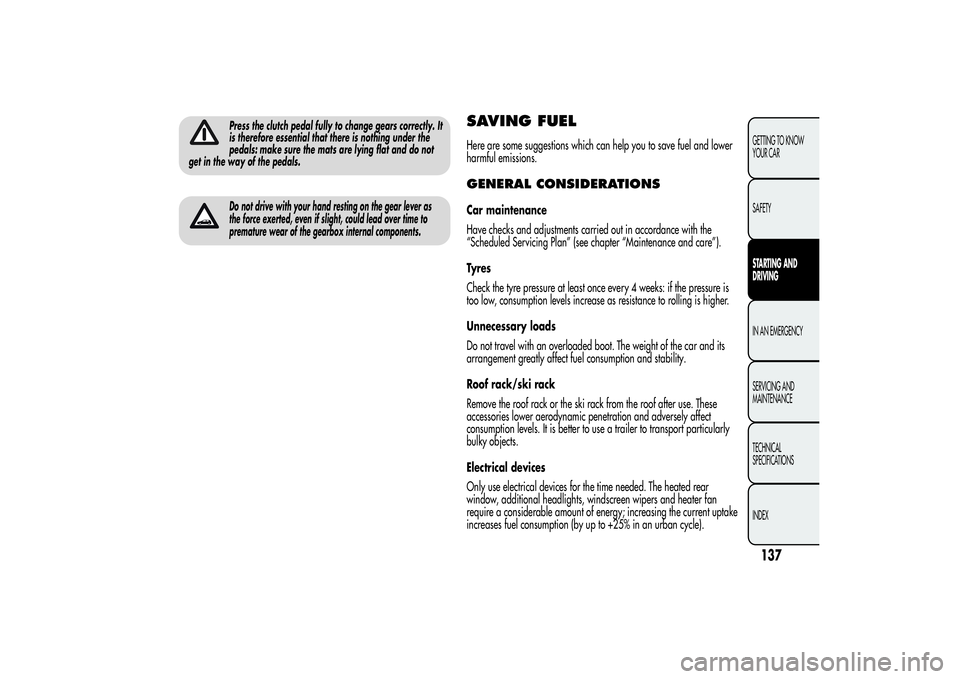
Press the clutch pedal fully to change gears correctly. It
is therefore essential that there is nothing under the
pedals: make sure the mats are lying flat and do not
get in the way of the pedals.Do not drive with your hand resting on the gear lever as
the force exerted, even if slight, could lead over time to
premature wear of the gearbox internal components.
SAVING FUELHere are some suggestions which can help you to save fuel and lower
harmful emissions.GENERAL CONSIDERATIONSCar maintenance
Have checks and adjustments carried out in accordance with the
“Scheduled Servicing Plan” (see chapter “Maintenance and care”).
Ty r e s
Check the tyre pressure at least once every 4 weeks: if the pressure is
too low, consumption levels increase as resistance to rolling is higher.
Unnecessary loads
Do not travel with an overloaded boot. The weight of the car and its
arrangement greatly affect fuel consumption and stability.
Roof rack/ski rack
Remove the roof rack or the ski rack from the roof after use. These
accessories lower aerodynamic penetration and adversely affect
consumption levels. It is better to use a trailer to transport particularly
bulky objects.
Electrical devices
Only use electrical devices for the time needed. The heated rear
window, additional headlights, windscreen wipers and heater fan
require a considerable amount of energy; increasing the current uptake
increases fuel consumption (by up to +25% in an urban cycle).
137GETTING TO KNOW
YOUR CAR
SAFETYSTARTING AND
DRIVINGIN AN EMERGENCY
SERVICING AND
MAINTENANCE
TECHNICAL
SPECIFICATIONS
INDEX